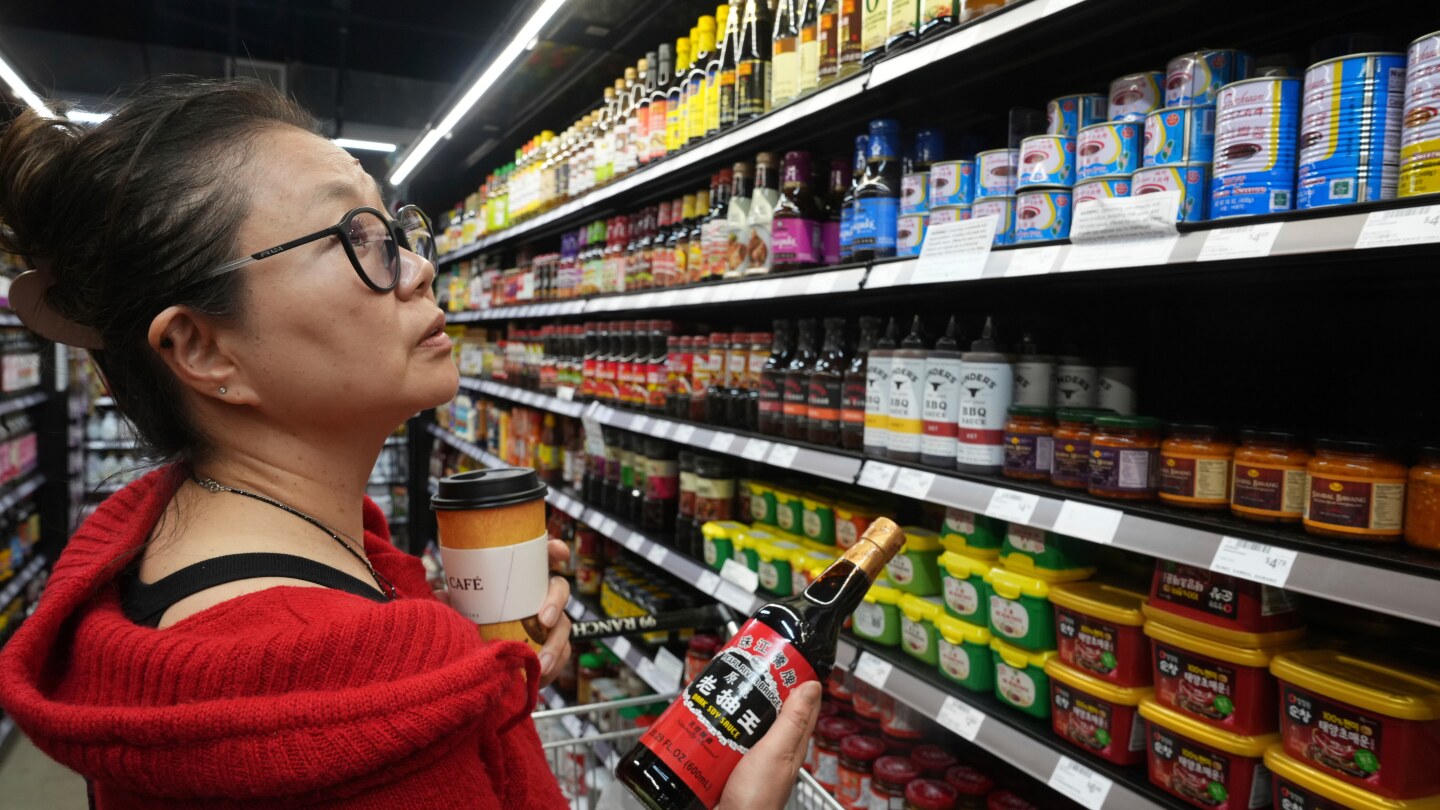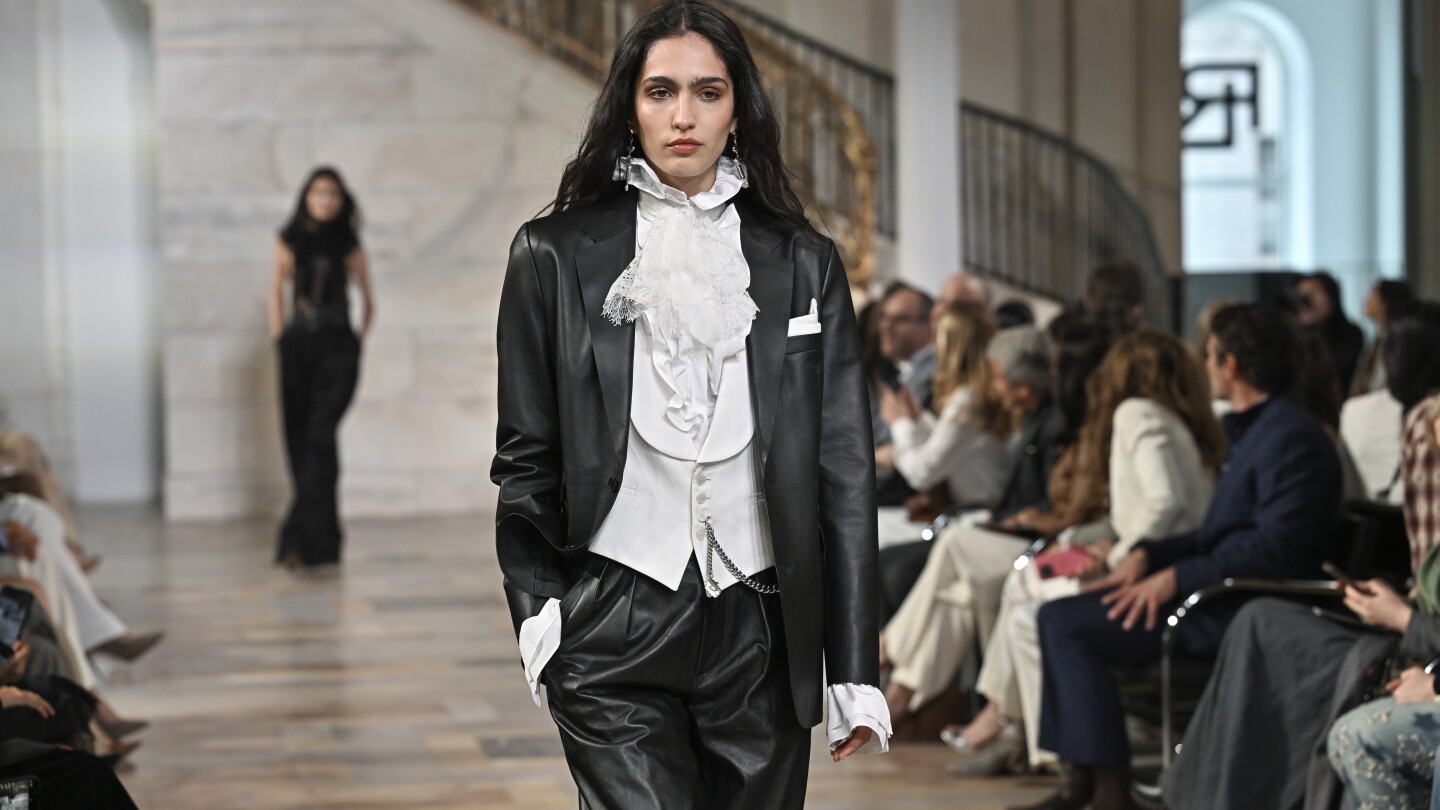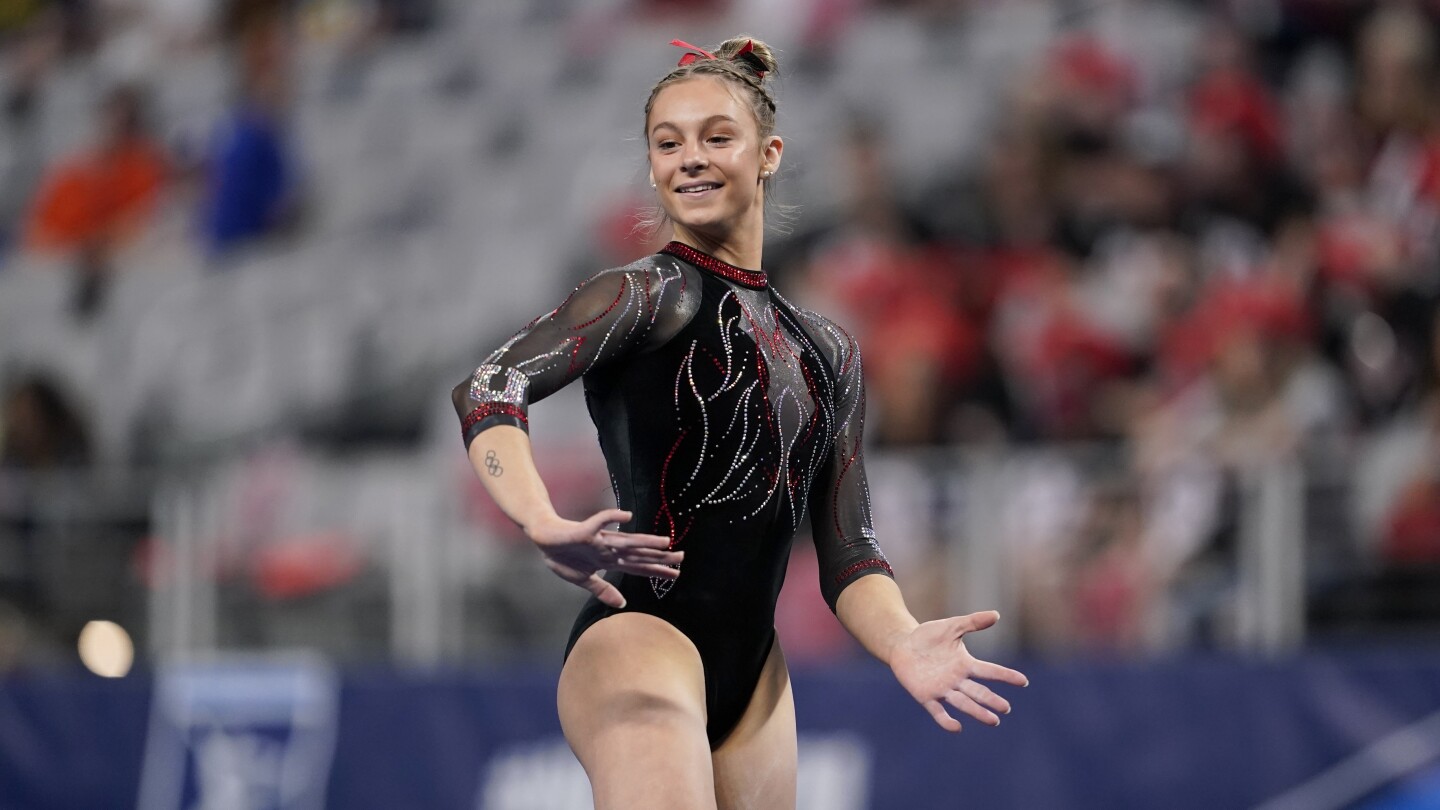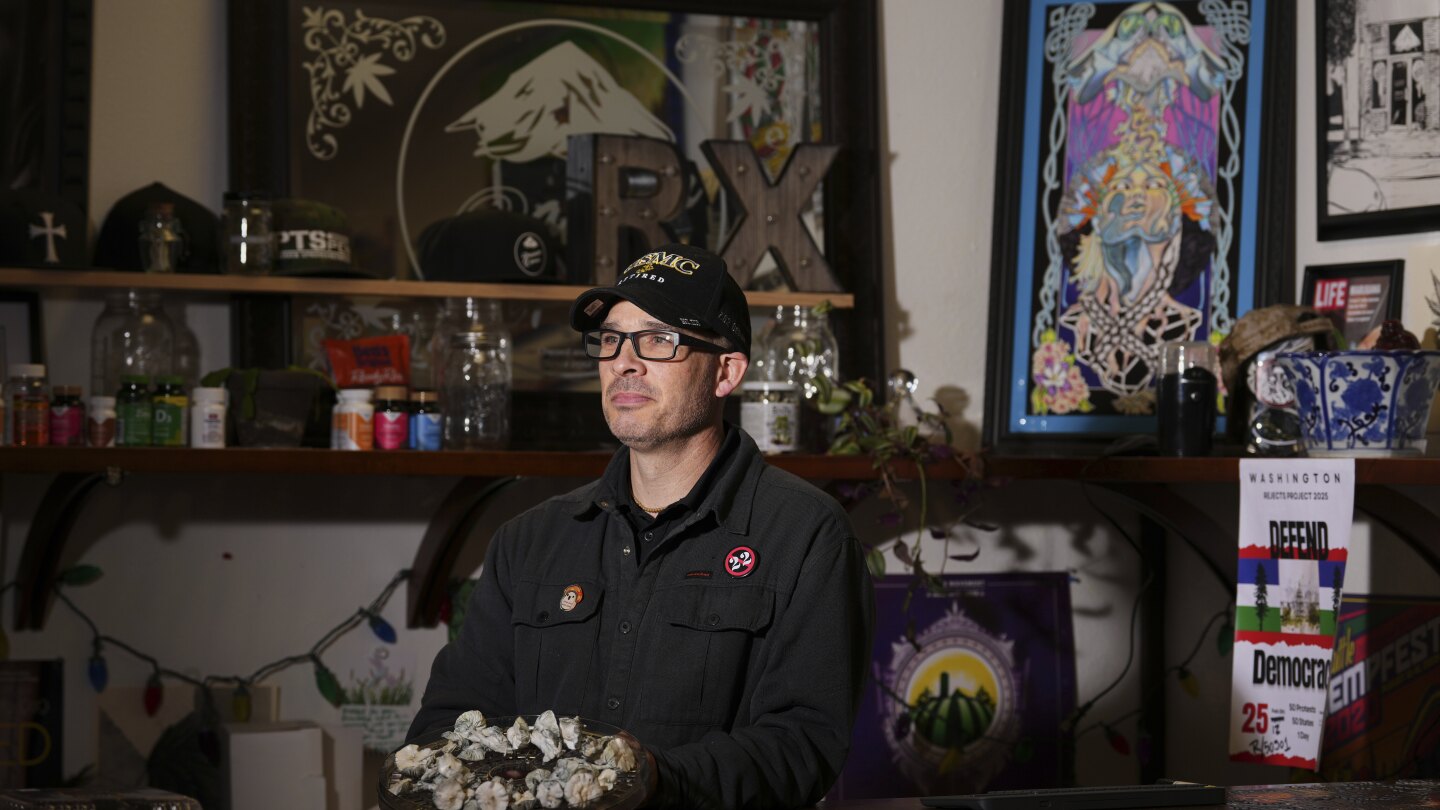Lifestyle
US tariffs on Asian countries have shoppers at specialty supermarkets worried about prices

LOS ANGELES (AP) — Loyal customers of Asian supermarkets and other grocery stores that specialize in selling imported food heaved a collective sigh of dismay when President Donald Trump announced extra-high U.S. tariffs on goods from dozens of countries.
What would happen to prices at 99 Ranch Market and H Mart?, wondered Asian Americans and immigrants who shop at the two American chains for preferred brands like Japan’s Kewpie mayonnaise and China’s Pearl River light soy sauce.
“We’re all going to be crying in H Mart,” a TikTok user commiserated, referencing the title of a bestselling memoir by Korean American musician Michelle Zauner as other posters shared videos of their “pre-tariff hauls” from Asian supermarkets.
The steeper tariff rates Trump set for imports from nations he accused of unfair trade practices took effect first thing Wednesday along with a 10% baseline tax on products from the rest of the world.
Several countries in Asia have some of the largest levies, including South Korea (25%), Vietnam (47%) and Cambodia (49%). After China approved counter-tariffs and said it would fight a U.S. trade war “to the end,” the president on Tuesday raised the rate on Chinese goods to 104%.
At a 99 Ranch Market less than a mile from the UCLA campus, one of the California-based chain’s 58 stores, regular shopper Artis Chitchamnueng said he won’t be able to go anywhere else to find the foods he likes if prices skyrocket.
“I think (Trump’s) just like playing a lot of like mind games of just trying to like take control of the market and stuff like that,” Chitchamnueng, a part-time worker and entrepreneur, said. Many customers have said on social media they don’t know if they will be able to continue doing their routine grocery shopping at 99 Ranch Market.
Even if mainstream grocers stock some of the same items, a lot of imported items are less expensive at the specialty supermarkets. An 18-ounce bottle of Lee Kum Kee Panda oyster sauce, for example, retails for $3.99 at 99 Ranch. The websites for Safeway and Walmart list the same bottle for $4.79 and $10.45, respectively.
The stores stocking a wide range of noodles, dried vegetables, herbs and skin care products from China, Japan, South Korea, Thailand and Vietnam can be a source of comfort for immigrants and foreign students craving the tastes of home.
Tony He, an international student at UCLA, said Trump’s tariff policies confused him but he would continue shopping at 99 Ranch to get his groceries if prices increase. “As long as I need Asian food, I usually come here,” He said.
Shopping for culturally specific foods, drinks and condiments in the U.S. has come a long way from the once-meager offerings found in the “ethnic food” aisles of American supermarkets. International supermarkets and small grocery stores across the country generated $55.8 billion in revenue last year, according to market research firm IBISWorld.
The sector has recorded an annual growth rate of roughly 3% since 2019, and an IBISWorld forecast predicted revenue for grocery stores with international brands would go up to over $64 billion by 2029.
Analysts attribute the increase in demand to the growth of Asian and Hispanic immigrant populations, as well as to the tastes of younger consumers who enjoy experiencing new flavors. Mass market stores and brands increasingly have stocked or created Americanized versions of Asian products to ride the trend.
The specialty rice used for sushi that mainstream supermarkets sell also is usually imported from South Korea, China or Japan, noted Nancy Qian, a professor of economics at Northwestern University’s Kellogg School of Management. She thinks tariffs may lead consumers to find alternatives for their favorite brands.
“When my parents first came to America in the ‘80s from China, they couldn’t really get the same type of rice as they did in China, So they switched to a different type of rice,” Qian said. “I think families and restaurants and people, they’ll do what it takes to make ends meet. And they’ll substitute foods. They’ll buy new foods.”
Independent shops that are integral to smaller Asian American communities are also bracing for a hit. The owner of Not Just Spices, a tiny South Asian grocery in Providence, Rhode Island, said he was concerned about rising costs for staple products such as basmati rice sourced from India and Pakistan, or the smaller-grained Kalijira rice from his native Bangladesh.
“When things are cheaper, people usually buy extra. Now they buy exactly what they need,” said Mohammed Islam, who has run Not Just Spices since 1998. “People are scared of spending any money because they don’t know what’s going to be happening.”
Trump announced a tariff of 37% on goods from Bangladesh, 26% on neighboring India’s products, 29% on items from Pakistan and a whopping 44% on imports from the island country of Sri Lanka, known for its cinnamon and other spices.
If he does have to raise prices as the tariff’s impacts start to hit supplies, Islam trusts his customers won’t blame him.
“People don’t complain because it’s already in the news,” he said. “It’s not like I’m the one who is raising the price.”
Customers at Hispanic supermarkets also may be shopping more carefully. Trump has repeatedly threatened to impose a 25% tariff on most imports from Mexico.
In Phoenix, roommates Andrew Colvin and Mario Aviles typically patronize Los Altos Ranch Market, where they say the bulk of the produce and snacks they buy are from Mexico. The sprawling supermarket, which includes a deli and a bakery, is one of the 115 stores the Heritage Grocers Group operates in six states.
“We expect pretty much everything to go up,” said Colvin, who was stocking up on Parrot canned coconut water, his favorite drink, in case the price goes up. “I probably eat 14 avocados a week. There’ll be a lot less of that.”
Aviles doesn’t want to shop elsewhere. If tariffs result in serious sticker shock, he is prepared to restrict himself instead.
“No more avocados, no more mangoes, no more orange,” Aviles said.
Some experts say it wouldn’t hurt to stock up on non-perishables within limits and individual household budgets. But shoppers need to avoid the “panic buying” that accompanied the start of the COVID-19 pandemic, which could create shortages and cause additional price increases, Qian said.
While it’s not yet clear how much of the tariffs will get passed onto U.S. consumers, researchers say any price increases would disproportionately affect low-income households.
“These are regressive taxes. And for the elementary reason that affluent people do not spend 100% of their incomes and disadvantaged people do,” Steven Durlauf, director of the University of Chicago’s Stone Center for Research on Wealth Inequality and Mobility.
Northwestern University’s Qian said the cumulative economic impacts of Trump administration tariffs may hold one possible silver lining if they bring people back to the cultural enclaves of major cities.
“If you think about the old Chinatowns, or the old, like, Little Italys of America,” she said. “The reason that those places became really important for their communities was because that was the only place where you can get the thing you wanted.”
___ Tang reported from Phoenix. Associated Press video producer Akira Kumamoto in Los Angeles, California contributed to this report. Associated Press writer Matt O’Brien in Providence, Rhode Island, contributed to this report.
Lifestyle
Ralph Lauren stays closer to home this time with intimate Manhattan gallery show

NEW YORK (AP) — Ralph Lauren, known for staging elaborate runway shows in sumptuous settings like the horsey Hamptons or amid his vintage car collection, took it down a notch for a more intimate show Thursday in a Manhattan gallery space.
As celebrities like Anne Hathaway, Michelle Williams, Julia Louis-Dreyfus, Ariana DeBose and many others watched from the front row, Lauren presented a fall collection dubbed “The Modern Romantics,” heavy on high ruffled necks, classics like buttery leather in everything from aviator jackets to bustiers, and soft cashmere. Evening looks were long and lacy.
Models descended a grand staircase in an airy gallery setting
Lauren’s models first appeared atop a balcony, then each descended a grand staircase to walk the runway. The venue, now the Jack Shainman Gallery, was built in 1898 in the Italian Renaissance Revival style.
For the New York-based crowd, it was much less of a journey than Lauren’s last show in the Hamptons on Long Island, which took some guests four hours from Manhattan in busy traffic.
Lauren himself appeared at the end of the show to wave — from the top of the balcony.
A romantic theme
Lauren said he was celebrating “The Modern Romantics,” an aesthetic he described as “self-assured and unbound by rules.”
Strutting the runway, the models displayed looks that began with a classic Lauren combination of black trousers, a high-necked ruffled white shirt, and an aviator jacket in brown distressed leather.
That was followed by a filmy white midi-dress paired with a thick black leather belt, and tall black leather boots.
A black leather bustier was paired with a long camel wool skirt, and white lacy ruffled shirts popped up in different ensembles — with a long camel coat, or a puffy brown cardigan. There were also white lace neckties. There were velvet jackets, including in a deep shade of purple.
Outfits segued into evening with long, silky or strappy gowns, one in a white crochet theme, another in sumptuous black lace. There was a black halter gown in tiers of ruffles spiraling around the body.
Celebs in attendance
Hathaway, Williams and Watts sat together in the front row, each in a Lauren-style trench or wrap coat. Hathaway, her hair pulled back in a tight ponytail, paired her coat with a pair of tan-colored jeans, embroidered with sequins and strategically shredded.
DeBose wore a smart gray suit that would go perfectly with next month’s Met Gala dress code: “Tailored For You.” Louis-Dreyfus wore a cropped leather jacket in light brown, with white trousers.
Also attending were Sadie Sink, Sarah Catherine Hook, Eiza Gonzalez, Andra Day, Kacey Musgraves and Ella Hunt, among others.
Seen and heard at Lauren’s show
“I thought it was very much his sensibility and what he believes,” Anna Wintour, the influential Vogue editor, said after the show, noting that Lauren’s fashion transcended trends. “He’s a designer that never looks to the left or to the right. He’s just very clear in what he wants to say and what his customer wants, and that’s one of the reasons he’s so unbelievably successful.”
Sarah Catherine Hook, who appeared in the recently concluded third season of “The White Lotus,” said she liked the collection’s ephemeral feel.
“I love anything timeless and I feel like this is the most timeless you could possibly get,” Hook said. “I love the masculine-feminine mix of it and this is my first time getting to wear a necktie, so I’m feeling pretty chic today.”
Lifestyle
Picking a team from bars to beam and hoping for 10s: Fantasy leagues in gymnastics are a thing

WASHINGTON (AP) — Thomas Bateman kept busy this year managing college fantasy teams in 12 different leagues, a lineup that included SECret Weapon and One and Dunne. Five of them won it all.
These were not teams stocked with NFL or NBA players. All 12 were made up of college gymnasts, and the Chicago-based marriage and family therapist is just one member of a fervent and growing fan base that channels their love of the sport into fantasy leagues.
“It’s such a great way to get to know the sport a bit,” Bateman said. “When I started off, I got these lists from College Gym News and picked athletes I didn’t really know, so then I got to know teams I liked and then got familiar with athletes I want to draft. It’s a great way to potentially grow the audience of the sport.”
Interest in gymnastics traditionally peaks with the Olympic cycle, but on the “gymternet” – the online global community for devoted fans – it’s a year-round sport. At the college level, major growth in name, image and likeness deals, viewership and streaming availability has been accompanied by a surge in fantasy leagues, too.
This year, over 7,000 women’s college gymnastics devotees have found their way to the Gymlytics and GymCastic fantasy platforms — all within the last few years.
From the Olympics to NCAA
Gymlytics, which launched before the 2022 collegiate season, runs through the regular season and has a postseason bracket competition. GymCastic, in its second year, offers weekly fantasy matchups, including the NCAA postseason and elite meets later in the year.
The two leagues take slightly different approaches. Gymlytics participants draft individual athletes for their team at the beginning of the season and set lineups for each week of competition. GymCastic runs a salary cap-style draft, in which athletes are valued at a certain number of “gym rubles.” Participants select athletes until their roster is filled while staying under the cap.
Neither are the first platforms of their kind: Founders of both pointed to Kristen Watkins, a former college gymnast and self-taught programmer who created and ran College Fantasy Gymnastics for the decade leading into the pandemic-canceled 2020 season, as an inspiration.
Watkins competed for the MIT gymnastics team until it was cut following the 2009 season, a period in which other college gymnastics programs were cut or coming under threat of reduction. The creation of the fantasy league, she said, was motivated in part because she wanted to see if there could be more interest in women’s gymnastics.
Subsequent leagues have hinged on the same idea.
“That’s the point of everything we do: It’s very, very specific to the gymnastics fans,” said Jessica O’Beirne, creator of the popular GymCastic podcast and a co-founder of the fantasy league of the same name. “We use the lingo of gymnastics. It’s so niche and so specific.″
The Gymlytics audience is similarly a lot of “diehard gymnastics fans,” said Lauren Pickens, a co-creator. That includes former athletes. Pickens recalled hearing from recently graduated members of the championship-winning Michigan team who had barely missed the Gymlytics draft deadline but wanted to put teams together. (She helped them join in.)
Growth beyond diehard fans
Like all fantasy team managers who care about results, Bateman and other participants have their hands full. Week to week, participants set lineups across the four apparatuses – vault, uneven bars, balance beam and floor exercise – to maximize the total number of points their team scores. An injury or struggles at a weekend meet are factors in roster changes.
Bateman joined Gymlytics in 2022 with friends who had been gymnasts at the University of Michigan. He named SECret Weapon after the Southeastern Conference, whose member school LSU is a repeat favorite at this week’s NCAA championships in Texas. One and Dunne bears the surname of LSU gymnast and popular influencer Olivia Dunne — and the name worked in a league where each team could include just one athlete from each college.
As GymCastic and Gymlytics have taken off, their creators have seen these diehard fans bring in friends and family who are less familiar with the sport.
″We’ve gotten a lot of emails from people saying, my significant other did fantasy basketball or fantasy football and because there’s a fantasy gymnastics, they wanted to connect with me and my passion so they joined a league,” said GymCastic COO Steve Cooper. “And now they’re screaming at the TV like I am.”
According to the Fantasy Sports & Gaming Association, the number of Americans over the age of 21 participating in fantasy sports grew by about 5% between 2017 and 2022. It’s been much more robust for Gymlytics, which launched its first season with 1,000 teams and, according to co-founder Yarden Tamir, had nearly 7,000 teams across 55 countries this season; and for GymCastic, which has seen over 10% growth between its first and second seasons, per Cooper.
While overall fantasy sports participation skews male by about a 2:1 ratio, according to FSGA data, the Gymlytics and GymCastic founders both estimated their participants were more gender balanced.
Higher visibility
Multiple fantasy gymnastics participants and founders pointed to the 2021 and 2022 collegiate seasons as a turning point. Those seasons followed the delayed Tokyo Games and a 2021 Supreme Court decision allowing college athletes to earn endorsement money, marking the beginning of Olympics gymnasts being able to cash in and retain their NCAA eligibility.
Other than Simone Biles, every member of that medal-winning Tokyo team, including alternates, went on to compete in the NCAA.
“Olympics is so fun but it’s hard to consistently follow elite athletes because oftentimes they’re only competing three or four times per year,” Bateman said. NCAA gymnastics “is fun, too, and it’s such an accessible format.”
Accessibility has also grown as streaming networks have jumped in. According to ESPN, the three most-watched gymnastics telecasts have been the three most recent national championships. In 2022, ESPN and affiliated platforms broadcast 40 meets across five platforms; after championships this year, it will be more than 60 meets across eight.
“FOX bought in this year. ESPN is doing GameDay-style shows to lead into their broadcast,” said Brandis Heffner, the managing editor of College Gym News and a fantasy player. “Giving that option to gymnastics fans has been a fantastic way to help build the sport.”
Running a custom fantasy league isn’t without its challenges. League officials pointed to challenges with data availability and inconsistent information across conferences and regions, including judging details.
Gymlytics and GymCastic have both gotten around it by leveraging the devotion among their participants, essentially crowdsourcing scores to get them into their databases. While there are improvements to be made on both the institutional and platform sides, the fantasy league founders all expressed optimism.
“There are a ton of little features we want to add and make the environment easier to use, more automated,” Tamir said. “If one actual person you don’t know uses it, that’s a huge win, but when thousands of users are using it on a daily basis, that’s wild. We’re just continuing to make that tent larger.”
___
AP college sports: https://apnews.com/hub/college-sports
Lifestyle
Believers say microdosing psychedelics helps them. Scientists are trying to measure the claims

Microdosing is gaining popularity with a new breed of health seekers. These self-experimenters take a very small amount of psilocybin mushrooms or LSD to try to reduce anxiety, stress and depression. Some claim the practice gives them access to joy, creativity and connection they can’t get otherwise.
This isn’t a full-blown acid trip — or even close. If you see visions, it’s not a microdose. People who microdose don’t do it every day. Instead, they take tiny doses intermittently, on a schedule or when they feel it could be beneficial.
One small study suggests any psychological benefits come from users’ expectations — the placebo effect. But the science is still new and research is ongoing.
The substances are illegal in most places, but the wave of scientific research focused on the benefits of supervised hallucinatory experiences has spurred Oregon and Colorado to legalize psychedelic therapy. Further opening the door to microdosing, a handful of cities have officially directed police to make psychedelics a low priority for enforcement.
This article is part of AP’s Be Well coverage, focusing on wellness, fitness, diet and mental health. Read more Be Well.
What are people who microdose reporting?
“I started microdosing and within a couple of months, I had a general sense of well-being that I hadn’t had in so long,” said Marine Corps combat veteran Matt Metzger.
He grows his own mushrooms in Olympia, Washington, where psilocybin has been decriminalized. Taking small amounts of psilocybin helps him cope with PTSD, he said.
In Loveland, Colorado, Aubrie Gates said microdosing psilocybin has made her a better parent and enhanced her creativity.
“It makes you feel viscerally in your body a new way of being, a more healthy way of being,” Gates said. “And so instead of just like thinking with your conscious mind, ‘Oh, I need to be more present,’ you feel what it feels like to be more present.”
What does the science say about microdosing?
These kinds of claims are hard to measure in the lab, say scientists studying microdosing.
For starters, belief is so important to the experience that empty capsules can produce the same effects.
In one study involving people who microdose, participants didn’t know until afterward whether they had spent four weeks taking their usual microdose or placebos. Psychological measures improved after four weeks for everyone in the study, regardless of whether they were taking microdoses or empty capsules.
“It appears that I was indeed taking placebos throughout the trial. I’m quite astonished,” wrote one of the study participants. “It seems I was able to generate a powerful ‘altered consciousness’ experience based only (on) the expectation around the possibility of a microdose.”
Scientists haven’t found lasting effects on creativity or cognition, according to a review of a handful of small placebo-controlled trials of microdosing LSD.
One small study did find glimmers of an effect of small LSD doses on vigor and elation in people with mild depression when compared with a placebo.
“It may only work in some people and not in other people, so it makes it hard for us to measure it under laboratory conditions,” said University of Chicago neuroscience researcher Harriet de Wit, who led the research.
The potential has spurred an Australian company to conduct early trials of microdoses of LSD for severe depression and in cancer patients experiencing despair.
Meanwhile, few rigorous studies of psilocybin microdosing have been done.
Psilocybin mushrooms are the most often used among psychedelic drugs, according to a report by the nonpartisan Rand research group. Rand estimates that 8 million people in the U.S. used psilocybin in 2023 and half of them reported microdosing the last time they used it.
A few words of caution about microdosing
Even microdosing advocates caution that the long-term effects have not been studied in humans.
Other warnings: Unregulated products from shady sources could contain harmful substances. And accidentally taking too much could cause disturbing sensations.
The nonprofit Fireside Project offers free phone support for people during a psychedelic experience and has received hundreds of calls about microdosing.
“People may call just to simply process their experience,” said project founder Josh White, who microdoses the plant iboga and LSD to “continue to deepen the insight about my life” that he gained in a full-blown psychedelic experience.
Balazs Szigeti of University of California San Francisco, who has studied microdosing, said it may be a way to harness the placebo effect for personal benefit.
“It’s like a self-fulfilling prophecy,” Szigeti said. “People who are interested in microdosing should give microdosing a try, but only if they’re enthusiastic about it, if they have a positive expectation about the benefits of microdosing.”
___
The Associated Press Health and Science Department receives support from the Howard Hughes Medical Institute’s Science and Educational Media Group and the Robert Wood Johnson Foundation. The AP is solely responsible for all content.
-

 Education1 day ago
Education1 day agoTrump administration revokes humanitarian parole of Spanish teacher
-

 Conflict Zones9 hours ago
Conflict Zones9 hours agoHaiti in ‘free fall’ as violence escalates, rights group warns | Armed Groups News
-

 Sports2 days ago
Sports2 days agoStephen Curry and Jimmy Butler lift the Warriors past the Grizzlies and into the NBA Playoffs
-

 Europe1 day ago
Europe1 day agoCody Balmer, the suspect in arson at Pennsylvania governor’s home targeted the governor for his views on war in Gaza, warrant says
-

 Sports1 day ago
Sports1 day agoNew Orleans Saints win lawsuit over fleur-de-lis trademark filed by ‘direct descendant of the Kings of France’
-

 Africa1 day ago
Africa1 day agoWorld Trade Organization says global trade could slide this year due to tariffs
-

 Europe1 day ago
Europe1 day agoLive updates: Trump news, immigration and tariff updates
-

 Education2 days ago
Education2 days agoReggaeton is sending China wild — and it’s teaching college students Spanish




